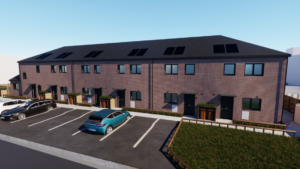Anfield’s regeneration: playing the long game

The new main stand expansion takes shape at Anfield, home of Liverpool FC.
Two years on from when the builders and bulldozers moved in, there is a feeling that real, long-term regeneration is happening in the Anfield neighbourhood.
Resident Linda Shea believes that better times beckon for an area in which she has raised a family and lived for more than 30 years: ‘All this work being done is a sign that things are improving and the area will pick up again and it will be lovely when it’s finished. We’ve waited a long time.’
In 2013, a new partnership of Liverpool Council, Your Housing Group (YHG) and Liverpool FC came together to unveil a £260m vision to transform the area – the Anfield Regeneration Project. The football club committed to carrying out various studies to ascertain whether a stadium expansion was feasible and with a positive consultation Liverpool FC was able to confirm their project would go ahead from late 2014.
As fans from across the UK and beyond return to the neighbourhood to watch the Reds compete in the 2015/16 Premier League, the most visible sign of progress is the huge steel structure of LFC’s new main stand, rising into the sky. Behind the stadium, too, major progress has also been made to build and refurbish new homes for local people.
In the last two years alone, some 188 sub-standard and derelict properties have been demolished, many of them to make way for the proposed development of a new hotel and business centre, an avenue, public realm and retail premises.
Almost 200 homes, meanwhile, have had major external improvements carried out by the city council, including new rendering, roofs, windows and doors. More than 50 occupied YHG homes have had major internal improvements, such as new kitchens, bathrooms, damp-proofing, re-plastering. YHG has in addition carried out 12 innovative property conversions to create new large family homes out of two traditional terraces. The social landlord, which is a regeneration specialist, has also remodelled a further 25 vacant properties bringing them up to modern standards.
 Lorraine Donnelly, development director for YHG, believes the work to convert two traditional terraces into larger family homes has been really successful: ‘The old two-up/two-down terraces simply weren’t suitable for modern families, but we’re delighted we’ve been able to retain those buildings and adapt them to modern requirements.’
Lorraine Donnelly, development director for YHG, believes the work to convert two traditional terraces into larger family homes has been really successful: ‘The old two-up/two-down terraces simply weren’t suitable for modern families, but we’re delighted we’ve been able to retain those buildings and adapt them to modern requirements.’
On the other side of the high street, meanwhile, housing developer Keepmoat has built a further 83 new homes in the last two years to add to the hundreds of new homes, new health centre and new primary school which had already been developed.
The city council is also in advanced negotiations with tenants, businesses, owners and community organisations with an interest in the high street over its future redevelopment. It is likely that the redevelopment of individual blocks on the high street to create a mix of new retail, community and residential facilities will begin early 2016 subject to consultation and planning consents. Plans will emerge later in 2015.
A range of improvements have also been made or are in the planning stages to improve the environment in Anfield/Breckfield, including the creation of pocket parks between houses, where formerly derelict homes stood. The city council will also be undertaking works to Stanley Park car park and the immediately adjacent green space later in the year in readiness for the stadium’s main stand expansion opening.
‘Residents are a key partner in everything we do and I think the community needs to take a massive pat on the back for sticking with us and working through and not losing faith or heart’ – Cllr Ann O’Byrne, deputy mayor of Liverpool
So how has this change come about? The city council knew it needed to act and drew up plans to deliver housing regeneration. It aimed to keep 600 properties, refurbish and adapt some and clear others to allow them to maximise potential economic growth as well as create space.
Mark Kitts, assistant director of regeneration at Liverpool Council, says they worked hard to convince residents that they were now the focus, in a new era of collaboration: ‘This time, from day one, we have involved the people, consulted with them on ideas, put plans into the public domain and then reached an agreement in taking them forward.
‘We now have a project where nothing is planned nor managed in isolation and the four key delivery organisations are in regular dialogue on how best to deliver the scheme.’
Liverpool’s deputy mayor, Cllr Ann O’Byrne, adds that the change of approach is bringing benefits: ‘The difference is now this is not about “doing to” the community but working with the community to ensure they are involved step-by-step.
‘Residents are a key partner in everything we do and I think the community needs to take a massive pat on the back for sticking with us and working through and not losing faith or heart.’
The partners have all worked hard to deliver change In Anfield, there is also an understanding now that this is neither football nor housing led regeneration, but about creating a destination in the city, with football at its heart.
 It is clearly to the club’s advantage that it doesn’t only have support from football fans. As a 650-tonne roof truss is erected over the main stand, the club’s chief executive, Ian Ayre, emphasises the importance of relationships: ‘This ongoing transformation marks an incredible chapter in the club’s history, which will create a stadium that we hope our fans and the local community can be proud of and enjoy.
It is clearly to the club’s advantage that it doesn’t only have support from football fans. As a 650-tonne roof truss is erected over the main stand, the club’s chief executive, Ian Ayre, emphasises the importance of relationships: ‘This ongoing transformation marks an incredible chapter in the club’s history, which will create a stadium that we hope our fans and the local community can be proud of and enjoy.
‘It’s important to mention the continued support that local residents, businesses and community groups have given to the regeneration project, which has both helped to shape the process and progress it.’
It’s a reflection of the greater strength in unity in the area that Mark Kitts believes is already making the project a success: He said: ‘Liverpool FC is a more conscientious neighbour than ever before. The way they address residents’ issues is a testament to how hard they are working.’
The partnership also made it clear from the start that it wasn’t just investing in bricks and mortar and the environment, but also the people who live and work in Anfield.
The proposed new hotel in the new Anfield Square is a key plank in that ambition. Not only is it likely to be operated by a high end international brand, it will also offer training in the hospitality industry to the area’s young people in line with the existing Hestia Careers project which is already delivering apprenticeships.
Cllr O’Byrne says: ‘We all recognised that improving economic conditions, job prospects and life chances was key for this project to succeed in the long term.
‘We put a project office right in the middle of the area (staffed by YHG) from day one and that is for people to go in and ask questions, but also to get job advice from employment agencies.
‘We are making sure that contractors on site and housing associations are working with local businesses because they employ local people who are much more likely to take on apprentices from the community and train people in those skills.’

Craig and Katie Bailey outside their new home.
The football club has also been part of the plans to increase employment and skills in the neighbourhood from the start, taking on apprentices within their staffing structure and using Hestia Careers to recruit local youngsters in matchday hospitality while stadium constructors Carillion have recruited apprentices in the same way.
Cllr O’Byrne adds: ‘Having local people working on the properties brings a massive sense of ownership, they want to see this project succeed, whether it’s older people taking the opportunity to reskill or younger people getting the first job that they have ever had.’
YHG is also moving their headquarters into the heart of Anfield: ‘It sends a very strong message about their commitment to the area and it will bring added footfall all week, which will attract further activity,’ asserts Cllr O’Byrne.
“This was never going to be short term, because it’s also about demonstrating our commitment to the whole of North Liverpool and the wider regeneration of the area and to the residents and young people who live there.’
The intangible success of the project thus far is also evident in the restoration of confidence and hope.
Linda Shea and her son David have taken advantage with both successfully applying to buy a home for a pound: ‘It’s a good community here, the best thing about Anfield is its people and the spirit,’ says Linda.
Craig and Katie Bailey with their new baby Oscar have also bought a similarly priced property and it’s transformed their prospects: ‘We’d been hoping to get on the property ladder for a while. Getting this house means that we can stay in the community we love and provide a stable home for our child.’
These intangibles, says Cllr O’Byrne, are an indication that the project is already a success: ‘People and businesses want to stay, others are waiting to move back into Anfield and people are taking pride in their streets and the communities and are not prepared to tolerate any more blight.
‘They are saying that this is ours and we want it be a nice place to live, a place to bring up their children. Given all that has gone before, that is amazing.’
Cllr O’Byrne believes this regeneration project in the home of the Reds is a blueprint for the future: ‘We think this is the way to deliver regeneration, and we have started to roll it out in other areas. Despite different areas having different partners and challenges, the approach is to put the community at the heart of what we do.’
















Great news for all concerned.
Renewing existing homes where they can deliver good quality homes with limited future investment for 30 years makes perfect sense.
Integrated renwal of neighbourhods as is outlined is important becasue it only works where there are communities who want to stay and be engaged in the process.
40 years from SNAP the lessons are being learned and what’s more being acted on.
Born and brought up in the Dingle and living in south Manchester since 1970, I didn’t expect to hear of SNAP again.